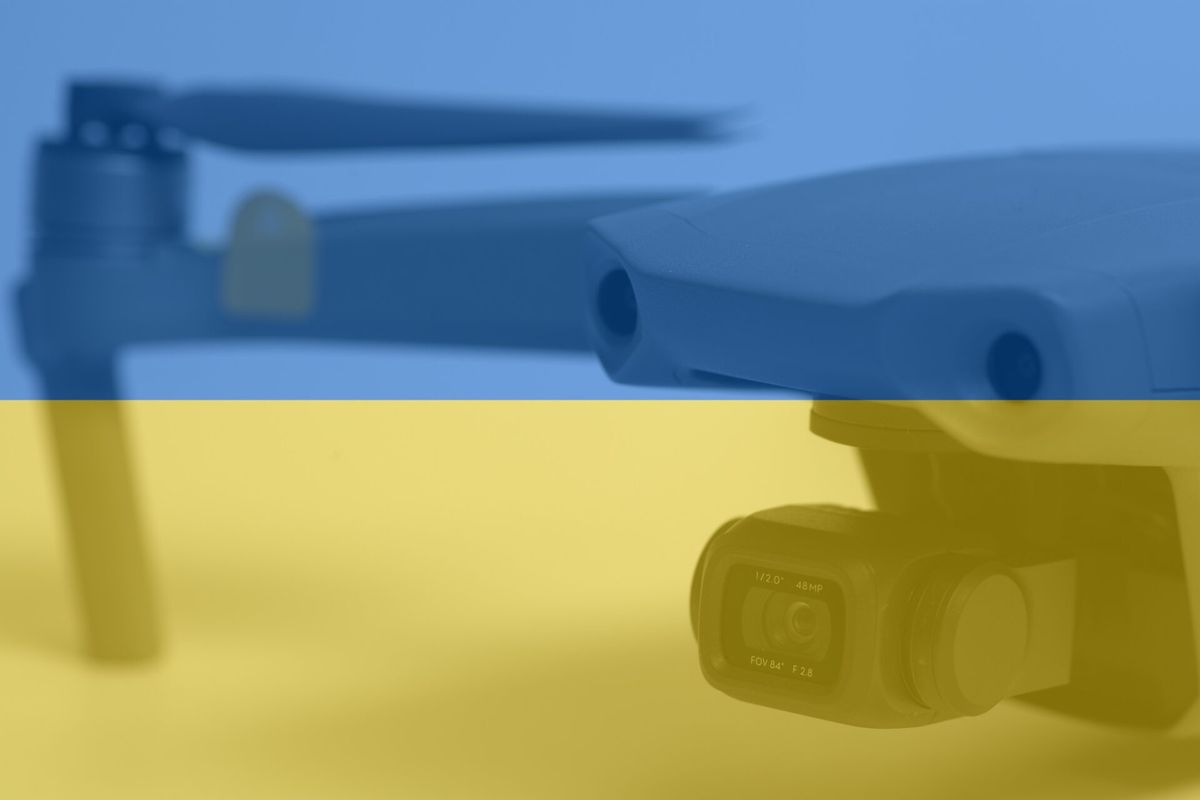EXPERT PERSPECTIVE - Russian authorities say they shot down a Ukrainian drone over the area that serves as headquarters for the Russian Black Sea Fleet in Crimea over the weekend.
The incident follows another incident three weeks ago, in which Reuters is reported that five members of the Russian navy were injured by an explosion in the courtyard of Russia's Black Sea Fleet in Russian-occupied Sevastopol. The explosive was believed to be carried in by a drone in yet another indicator of how the technology is being leveraged since Russia's invasion of Ukraine.
Since the start of the invasion in February, we've seen drone applications as lethal weapons systems and as ISR (intelligence, surveillance, reconnaissance) platforms. But beyond the battlefield, there is equal anticipation of the commercial and personal uses of drones for product delivery and hazardous area inspection among dozens of other possibilities.
From the stratospheric Zephyr unmanned aerial system (UAS) prototype that soars at 70,000 feet, to the 'off-the-shelf' version that hovers just a hundred feet off the ground, drones cover an amazing range of form and function, and the prospects for their future development are as expansive as the airspace they glide through.
In the third installment of The Cipher Brief's drone series, we're talking to the experts about what's over the horizon for this technology and what technological innovations will help reinforce present capabilities and bring about new applications.
THE EXPERTS
August Cole, Author, Lecture, Futurist
August Cole is a non-resident fellow at The Brute Krulak Center for Innovation and Creativity at Marine Corp. University and is co-author of Burn In: A Novel of the Real Robotic Revolution and Ghost Fleet: A Novel of the Next World War. He is also a former reporter for The Wall Street Journal.
Alec Bierbauer, Former CIA Officer, Directorate of Operations

Alec Bierbauer is a former CIA Officer and CEO of Blackrock Strategy. He is co-author of Never Mind, We’ll Do It Ourselves: The Inside Story of How a Team of Renegades Broke Rules, Shattered Barriers, and Launched a Drone Warfare Revolution.
Mark Cooter, Retired Colonel, U.S. Air Force
Mark Cooter is a retired United States Air Force Colonel and served as an intelligence officer for 28 years. Since retiring from active duty in 2013, he’s served as the Director of Intelligence, Surveillance, and Reconnaissance Operations for PatchPlus Consulting, Inc. He is co-author of Never Mind, We’ll Do It Ourselves: The Inside Story of How a Team of Renegades Broke Rules, Shattered Barriers, and Launched a Drone Warfare Revolution.
THE DEBRIEF
The Cipher Brief: “Autonomy” seems to be one of the key buzzwords in discussions of drones. What trends (e.g., in AI, sensors, power sources) are developing to make these platforms as independent of human involvement as possible?
Cole: Robotic autonomy in everyday life is coming, and that will carry over into its use in conflict. Will this be an area where military development actually leads to commercial usage? It’s more likely that commercial autonomy research and development into areas that lead to ubiquitous autonomy will create code and engineering knowledge that feeds the other way. Ultimately the potential of drones in any environment is driven by software more than hardware, and that is the case with designing how much autonomy they can safely and successfully operate with. Currently, software is an easier area for private industry to lean into in terms of development than hardware; it scales and doesn’t require factories like a hardware-focused effort might, for example. This could, however, be an area where military innovation in government or the defense sector may take a cue that there’s a sort of arbitrage that needs to be done if the United States and its allies are going to truly build and buy useful autonomous systems.
Bierbauer: There is absolutely a push toward autonomy. I think it's driven by the maturing of the technology and less so by the government side pulling for autonomy, but it's there. What I've seen over the last 24 months is a rapid push to give the data, and that data processed into intelligence, to war fighters on the ground and taking that burden off of the aircraft operators and the sensor operators. Now the drive is absolutely to get — not necessarily operating the platforms by the guy on the battlefield — but getting the data from those sensors and the ability to fly or operate that sensor from the battlefield. Now you've got the lieutenant platoon leader on the ground able to pull real-time imagery, signals and intelligence from a drone without being accountable or responsible for the drone. I think the technology is there to give autonomy to platforms and autonomy to sensor operations. Now you have the ability to put a whole lot of data on the battlefield to ground commanders and at very senior levels down to that platoon leader. So we have to adjust and figure out how to use that new autonomy.
Cooter: There are a lot of things over the last 20 plus years that have not been autonomous, but very labor intensive. How you go through masses of data and get them quickly out to the soldier or marine has been a challenge. And we've made some strides, but there's still a long way to go in that realm. Obviously, another advantage of more autonomy is that if you free up what you have to send over a command and control link, you can now use links that have lower probability of intercept, which helps you more in a near peer environment. And certainly how you handle larger remotely piloted aircraft versus handhelds is very different. And the countermeasures to them can be very different. So it's a complex thing. I think there are things we definitely can do better. We have to watch about what our adversary is going to do as well. Because their calculus is going to be different than ours, but like I said, it's a complex thing on how much autonomy you're going to give out there and what decision making you can create through that artificial intelligence, etc.
The Cipher Brief: Drone swarms are another focus of media coverage, especially for their anticipated use in military and combat operations. How do you separate reality from fantasy in projecting the usefulness of drone swarms for military purposes?
Cole: Once I get past the depictions in novels, video games, or movies, it’s important to remember that these are technology systems that have the same limits and challenges as software- and battery-powered devices today. If swarms are to be militarily useful there has to be consideration about things like, how do you keep the batteries all charged up in a 100-drone swarm? Huge footprint in terms of physical space and electronic emissions. Who wants the job of making sure they are all plugged in or nested on their charging cradles when there’s incoming artillery? Or making sure the inertial navigation software update is the right one? That stuff doesn’t have much sizzle but it’s vital when thinking about their real-world relevance during future conflicts. In fact, it’s great grist for fictional depictions of realistic robotic warfare. Whether it’s birds of prey or long-rifles that look like they could be in a 90s sci-fi flick, drone countermeasures tend to ignore this aspect. That may be OK if you’re protecting a stadium or a VIP, but effective future drone countermeasures need to encompass the entire operational energy, supply, and command and control chain long before the moment a drone is a threat.
Bierbauer: I think the capability for the drone swarm is there. And, and we see it now on the entertainment side, we see firework shows being replaced with synchronized drones. I mean, that truly is an integrated coordinated drone swarm, just for entertainment rather than a military application. I think you're seeing the potential for the precision strike is there now, but one of the first things in conflict is suppressing enemy air defense so you can get your aircraft in, what better way to do so than overwhelming it.
The sinking of the Russian ship, Moskva, is a great example if, in fact, the crew was distracted by drones; an example where it doesn't have to be hundreds, it can be a handful. To the point that you only need one to get through potentially. So the real time command and control of a drone swarm is probably there in some scenarios and not in others. And we compare it with the earlier autonomy discussion, do you need real-time command and control of hundreds, dozens, whatever the number is. What is attritable, what is low cost? What is it that we can afford to lose if we're going to say that the saturation of numbers on a target or in the area of the target is important. But from our perspective, we look at it and say, "There's no pilots on board. It's just money."
Cooter: Is the drone swarm any different than groups of B-17s flying over Germany in World War II when we didn't have precision strike capability? So it was about inundating the target versus now, when we've improved our targeting ability. If you look at trying to get through an air defense system to hit some valuable target, we sometimes put multiple F-16s against that in order to saturate that defense system. Obviously, the ability to use unmanned platforms for that could be significant, depending on an adversary's ability to counter or the reverse — an adversary coming at us and say a carrier’s ability to defend itself and have the counter-measures to take down those drones rather than have your defense system saturated. So the swarm could be a significant threat for sure.
Everybody concentrates on the drone platform itself, but as we found out, it's a marriage of the drone with the sensors, or weapons, or other capabilities, you're going to link to that. Most important are the tactics and techniques and procedures on how you're going to utilize that. I think you're seeing the difference between how the Russians and the Ukrainians use these. I think there's some analysis to be written there on how the Ukrainians have been very innovative. You see young people using their own commercially bought handheld drones to support the defense of their country. And I think the swarm is one of those things. It's the art of the possible based on how somebody's going to employ them.
The Cipher Brief: Let's talk about how quantum computing may impact drones in the future, whether that means better maneuvering, operating in inclement weather and difficult terrain or more quickly adapting to changing environments like combat zones. What role do you think quantum computing will play?
Cole: Quantum computing may be the technology with the greatest disruptive potential in any sphere, be it political, economic, social, or military. When it comes to drones, depending on where in the operational cycle of a sortie or deployment, quantum computing could allow extremely secure communications between drones or a larger network; put another way, unhackable drones. Yet quantum’s potential may be greater in a ‘back office’ sense, meaning that it could essentially supercharge capabilities like we have already today but give radically more capability. A drone could have sensors so they can see beneath city streets to locate subterranean targets or communicate information with more range and fidelity than before. Progress is being made for more powerful quantum machines (entangling longer strings of qubits), but those strings are quite fragile and sensitive. Any machine system is a series of tradeoffs among power, weight, size, etc. so a crucial question with drone and network design is where are the tradeoffs being made to account for the current and near-term fragility of creating quantum entanglement.
Bierbauer: This really ties to earlier discussion of autonomy and the advances that are giving control to the aircraft with an operator out of the loop or an operator in a monitoring role. There are dozens, probably hundreds of companies exploring quantum to be able to support computing capabilities and get that autonomy and independence squarely on the aircraft. By the way, the regulatory side of that is going to be way behind.
If we're concerned about controlled swarms and how that gets regulated, we're a long way off from push and pull autonomy. There's some really impressive projects being worked in industry that are going to make this reality much sooner than I would have thought. We just have to figure out how to apply it. And that's the big government side of things — how do we want to creatively and responsibly use what's going to be available to us? And you can have some great ethical, moral conversations about how much independence do you want to give to a platform.
Cooter: I think quantum is just the next stage in evolution. When you look back 20 plus years, anything that the drone was going to do it had it to be told to do unless it was damaged and just heading home. Advances such as quantum improve the ability to process either onboard sensors or data from somewhere else. And the ability to execute those things improves its survivability and improves the timeliness by which it can take actions. So I think that's just another piece of the evolution.
The Cipher Brief: What do you think the next physical environments for drones will be – maritime, hazardous or remote regions, subterranean or subsurface? And what advances are needed for drones to operate in more demanding surroundings?
Cole: On one hand the final frontier for drones might be literally the final frontier, space. Or, perhaps, the undersea, where crewless craft and vessels could pioneer new knowledge about the ocean. But the ultimate challenge for drones in military use will most likely be economics and the defense industrial base. As drones get more capable, there will be a desire to make them yet more capable –– and of course more costly. As drones take on higher stakes missions, they will need to be more reliable. There’s an asymptotic cost point at which growing capability of a remote system risks hitting the same price points as a crewed or piloted platform, without much commensurate benefit with the parity. Moreover, the expense of deploying a drone is not just the platform and its sensors, and also its code, but the attendant support systems it requires. Greater ambition for those drones is going to drive up the cost, and paradoxically decrease their utility. Developing disposable large drones more akin to munitions in usage that accompany forces from one conflict to the next may be the final frontier.
Bierbauer: I think surface, subsurface, and subterranean autonomous vehicles all have potential. And I would not neglect space in this either. And you may say, "By their nature, satellites are somewhat autonomous and unmanned certainly." But I’m talking about self-navigating, space-based platforms capable of doing good and doing evil, along with defensive counterparts. So I think you need to add that dimension. There’s another consideration — how do we protect our autonomous vehicles from cyber vulnerabilities? It's a challenge to cyber-harden autonomous systems because you have drones and counter drones and counter-counter drones. And one of the attack vectors is cyber. You don't have to have a kinetic solution or an RF-based solution if you can get inside their code. Potentially without touching the vehicle, you can manipulate that autonomous system.
Cooter: I think we've done applications in the maritime realms, and the subsurface as well as the maritime. There are lots of capabilities that have been used, some of them for years. The one thing we have to understand is that the constraints we put on ourselves policy-wise and otherwise aren't the same constraints that our adversaries will or won't put upon themselves. Are those threats real? Absolutely.
The other thing I would just to touch on since you talked about hazardous environments. The Air Force is actually rethinking its next combat search and rescue helicopter mix and considering that maybe it's unmanned systems that need to be picking up pilots who get shot down behind enemy lines rather than sending out 40 Marines like we did in Bosnia.
Bierbauer: Ideas like that — expanding the present use of drones — brings up the possibility of personal-use platforms. You've probably seen some of these concept vehicles, and the idea that everybody's going to have a quad copter or a multi-rotor personal transportation device in their garage. We're going to go full George Jetson. But that's very, very close. I mean, I think the technology is there. Again, regulatory considerations, that will be interesting to watch. But most of those are just a short step from being unmanned. The fact that you need somebody in the quad copter to navigate it I think is quite unnecessary, the flying Tesla.
The piece includes research, analysis and reporting by Cipher Brief Analyst Ken Hughes
Read more expert-driven national security insights, perspective and analysis in The Cipher Brief















